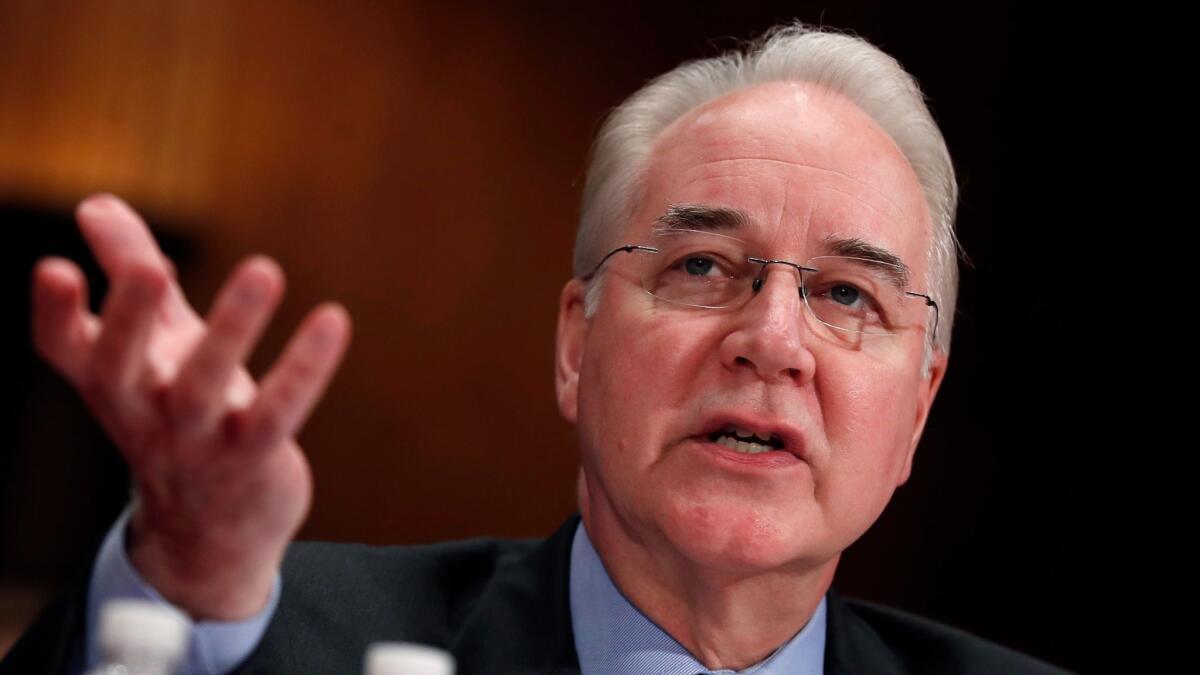Column: Tom Price may be gone, but the Trump administration’s sabotage of Obamacare is moving ahead at full speed

Health and Human Services Secretary Tom Price is gone, ushered out of office last week after being caught causing $1 million in unnecessary taxpayer expense by chartering private planes and taking military aircraft around the country and the world instead of flying commercial, like normal people.
This looks like a case in which the right thing has happened for the wrong reason — or at least for an incomplete reason. The grounds for Price’s ouster should have been his atrocious management of the most important program under his jurisdiction, the Affordable Care Act. Instead of acting to make Obamacare work better for all Americans, Price took every step within his power to undermine the law in ways that will cost American families millions of dollars.
What’s worse, Price’s campaign will keep chugging along without him. Indeed, much of the damage from his tenure already has been done and can’t be reversed for this year or next.
Minnesota’s experience with its 1332 waiver application has been ... nightmarish.
— Minnesota Gov. Mark Dayton to former Health and Human Services Secretary Tom Price
Whether Price’s departure will change the administration’s approach to the Affordable Care Act isn’t clear, but the signs are not encouraging. Price’s stance dovetailed neatly with that of his boss, President Trump, whose disdain for the healthcare law and near-total lack of understanding for how it works have been clear since the presidential campaign.
Some commentators have expressed hope that Seema Verma, currently the head of the Centers for Medicare and Medicaid Services, might be the front-runner to replace Price and that she’d be less antagonistic toward the Affordable Care Act. It’s hard to know what makes them think so. Verma is a protege of Vice President Mike Pence, who hasn’t exactly been a defender of Obamacare.
As an Indiana bureaucrat when Pence was governor, Verma fashioned a program that expanded Medicaid for that state, but she has been silent on the attack on the ACA coming from within the Health and Human Services Agency. During her confirmation hearing in February, she seemed to rationalize cutting maternity care from the list of essential health benefits required of all health plans under the ACA, which suggests either that she has no idea how insurance works, no regard for the difficulties of finding maternity coverage in the pre-Obamacare era, or is willing to say just about anything to please her right-wing masters in the administration.
My colleague Noam Levey reported in May that Verma was complicit in an outrageous White House extortion attempt, when she told insurance executives that the administration would fund cost-sharing reduction payments to insurers — which Trump has been threatening to withhold — if the insurers would support repeal of the Affordable Care Act. This went over very badly with the executives, and Health and Human Services denied the story.
As head of the health agency, Price managed to tick off even Republican state administrations, which were doing their part to make the Affordable Care Act work better. Consider the experience of the bright-red state of Oklahoma. State officials worked closely with Price’s office for months to gain approval for a so-called 1332 waiver under the ACA. Their goal was to set up a reinsurance program with federal funding to help insurers manage the cost of high-risk enrollees so that premiums in the individual market could be lower.
In March, Price had sent a letter to governors specifically urging them to consider 1332 reinsurance waivers and providing a road map toward expedited federal approval. But then Price pulled the rug out. According to a blistering letter sent Friday to Price and Treasury Secretary Steve Mnuchin by Oklahoma Health and Human Services Secretary Terry Cline, the state and the feds had reached an agreement on Oklahoma’s application by Sept. 22. Formal approval, Cline was told, would be coming the following Monday.
Instead, Cline learned that day that approval “would not be provided, with no reason for the delay or a time frame for approval.” The state had no choice but to withdraw its application. “The lack of timely waiver approval,” Cline told Price and Mnuchin, “will prevent thousands of Oklahomans from realizing the benefits of significantly lower insurance premiums in 2018.”
As it happens, Price’s inaction will cost the federal government dearly. Cline indicated that 100,000 of the 130,000 Oklahomans in the individual market are insulated from higher premiums by federal subsidies, which rise as premiums rise. But 30,000 middle-class households in the state will have to pay the higher rates themselves, if they can — “in a market many … were forced to leave because premiums are unaffordable,” Cline wrote.
Price also hogtied Minnesota’s effort to create a similar reinsurance program. State officials thought they had a deal in which the federal Health and Human Services Agency would provide more than $200 million over two years to fund the program — only to learn in mid-September that in return for the appropriation, Price’s agency would cut $369 million from its funding for MinnesotaCare, a low-income health plan the state used to cover residents who made too much to qualify for Medicaid, but not enough to afford insurance on the individual market.
“In a complete turnaround and contrary to all previous direction from your agency,” Gov. Mark Dayton told Price in a Sept. 19 letter, “we have now been informed that Minnesota would lose more federal Basic Health Plan funding than we would receive in federal support for reinsurance.” He added: “Minnesota’s experience with its 1332 waiver application has been … nightmarish.”
These actions, especially the treatment of Oklahoma, have “magnified suspicions that the Department of Health and Human Services is more interested in undermining the Affordable Care Act than partnering with the states to stabilize the individual market for the nearly 20 million Americans,” former Pennsylvania and Oregon Insurance Commissioner Joel Ario observed over the weekend.
During his tenure, Price was responsible for issuing a string of dishonest and disingenuous statistics about the Affordable Care Act marketplaces and, tacitly or explicitly, endorsed the lies told about the system by Republicans such as House Speaker Paul Ryan (R-Wis.).
Price didn’t stop there in his campaign to destroy the Affordable Care Act. Under his supervision, Health and Human Services has cut the open enrollment period for plans sold through the federal exchanges, HealthCare.gov, from three months to six weeks; instead of running from Nov. 1 through the end of January for plans effective in 2018, it will run only until Dec. 15. Last-minute enrollees — who are legion — will discover too late that their deadline has passed. The only means of avoiding that is to run a vigorous marketing and outreach program — but Price cut the budget for that by 90%, claiming through department flacks that previous experience suggested that outreach had “diminishing returns,” an assertion contradicted by hard evidence. Health and Human Services also says it will shut down HealthCare.gov for 12 hours every Sunday but one during open enrollment — making it inaccessible for a good portion of the weekends when applicants would normally be signing up.
Just before leaving office, Price ordered the health agency’s 10 regional directors not to participate in state-based open enrollment events, an unprecedented withdrawal of federal support.
Administration sabotage of the individual insurance market is tied to more than half of the average 36% premium increases sought by insurers in 20 states analyzed by Charles Gaba of ACASignups.net. Gaba reckons that nine percentage points of the increase are due to actual medical inflation and 2% from the reinstatement of an Obamacare tax on insurers that had been suspended for two years. But five percentage points are accounted for by the administration’s signals that it won’t aggressively enforce the individual mandate, which requires everyone to carry health coverage; and another 17 points from uncertainty over the cost-sharing reimbursement payments.
Most of this could not have been done by Price alone, at least not without the tacit connivance of President Trump. The campaign to kill the Affordable Care Act marketplaces by neglect and interference won’t end with the end of Price’s tenure as health secretary. There would be no improvement without a firm, proactive effort by his successor, and the chances of that happening look to be nil.
Keep up to date with Michael Hiltzik. Follow @hiltzikm on Twitter, see his Facebook page, or email [email protected].
Return to Michael Hiltzik’s blog.
MORE FROM MICHAEL HILTZIK:
ICYMI: A new absurdity from the gun lobby is the deregulation of silencers
Las Vegas: The harvest of unspeakably lax gun laws
A nonpartisan tax group’s searing analysis of the GOP tax plan: Top 1% would get 80% of all benefits
More to Read
Get the L.A. Times Politics newsletter
Deeply reported insights into legislation, politics and policy from Sacramento, Washington and beyond. In your inbox three times per week.
You may occasionally receive promotional content from the Los Angeles Times.











